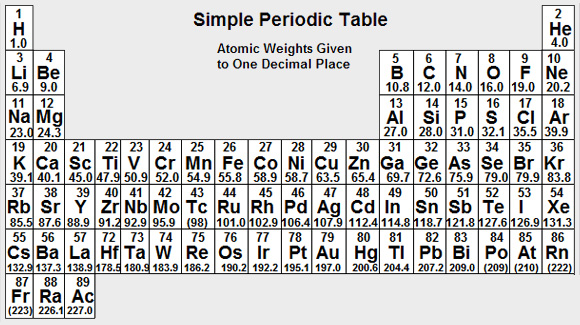For the next question, click on the Next Question button.
Question 1 of 5
What is the molarity of a 9.0 % w/v aqueous solution of Sodium Chloride? Answer to 4 significant figures.
- Find the mass of Sodium Chloride in 1000 ml of solution.
A concentration of 9.0 % w/v means that:
100 ml of solution contains 9.0 g of Sodium Chloride. Thus:
1000 ml of solution contains 1000/100 x 9.0 g of Sodium Chloride.
1000 ml of solution contains 90.0 g of Sodium Chloride. -
Find how many moles of Sodium Chloride there are in 1000 ml of solution.
Number of Moles of Sodium Chloride = Mass / RMM = 90.0 / 58.5 moles
Number of Moles of Sodium Chloride = 1.5384 moles
No, that is not the correct answer.
Have another go: just type in your new answer and press Enter.
If you continue to have problems, have a look at the answer.
For the next question, click on the Next Question button.
Question 2 of 5
What is the molality of a 5.9 % w/v solution of Succinic Acid ((CH2COOH)2) if the density of the solution is 0.820 g/ml? Answer to 4 significant figures.
- Find the weight of 100 ml of solution - use the given density of 0.820 g/ml.
1 ml of solution weighs 0.820 grams. Thus:
100 ml of solution weighs 100 x 0.820 g = 82 g -
Find the mass of solvent in 100 ml of solution.
100 ml of solution contains 5.9 g of Succinic Acid. Thus:
82 GRAMS of solution contains 5.9 g of Succinic Acid.
Mass of Solvent = Mass of Solution - Mass of Acid = 82 - 5.9 g = 76.1 g -
Find the MASS of Succinic Acid associated with 1000 g of solvent.
76.1 g of solvent are associated with 5.9 g of Succinic Acid. Thus:
1000 g of solvent are associated with 1000/76.1 x 5.9 g = 77.529 g of Succinic Acid. -
Find the number of MOLES of Succinic Acid associated with 1000 g of solvent.
Number of Moles = Mass/RMM = 77.529/118 = 0.65703 moles
No, that is not the correct answer.
Have another go: just type in your new answer and press Enter.
If you continue to have problems, have a look at the answer.
For the next question, click on the Next Question button.
Question 3 of 5
What is the mole fraction of Sucrose (RMM 342.0) in a 88.8 % w/v aqueous solution of Sucrose if the density of the solution is 1.332 g/ml? (RMM of Water = 18.02). Answer to 4 decimal places.
- Find how much 100 ml of solution weighs - use the given density of 1.332 g/ml.
1 ml of solution weighs 1.332 g. Thus:
100 ml of solution weighs 100 x 1.332 g = 133.2 g. -
Find the mass of water present in 100 ml of solution.
100 ml of solution contains 88.8 g of Sucrose. Thus:
133.2 g of solution contains 88.8 g of Sucrose. Thus:
Mass of Water = Mass of Solution - Mass of Sucrose = 133.2 - 88.8 g = 44.4 g -
Find the number of moles of Sucrose and Water present in 100 ml of solution.
Moles of Sucrose = Mass/RMM = 88.8/342.0 = 0.259649 moles
Moles of Water = Mass/RMM = 44.4/18.02 = 2.463929 moles -
Mole fraction of Sucrose = Moles of Sucrose = 0.259649
Moles of Sucrose + Moles of Water 0.259649 + 2.463929
No, that is not the correct answer.
Have another go: just type in your new answer and press Enter.
If you continue to have problems, have a look at the answer.
For the next question, click on the Next Question button.
Question 4 of 5
What is the normality of a 2.3 % w/v aqueous solution of Ammonium Chloride? Answer to 4 decimal places.
- Find how much 1 equivalent of Ammonium Chloride weighs.
Mass of Equivalent = RMM / Valency = 53.5 / 1 = 53.5 grams -
Find the weight of Ammonium Chloride in 1000 ml of solution.
100 ml of solution contains 2.3 g of Ammonium Chloride. Thus:
1000 ml of solution contains 23 g of Ammonium Chloride. -
Find the number of equivalents of Ammonium Chloride in 1000 ml of solution.
Number of Equivalents = Total Mass of Ammonium Chloride
Mass of One Equivalent
Number of Equivalents = 23 / 53.5 Eq = 0.42990 Eq
No, that is not the correct answer.
Have another go: just type in your new answer and press Enter.
If you continue to have problems, have a look at the answer.
Question 5 of 5
What is the % w/w concentration of a 3.266 % w/v solution of Sodium Acid Phosphate BP if the density of the solution is 1.008 g/ml? Answer to 2 decimal places.
- Find how much 100 ml of solution weighs - use the given density of 1.008 g/ml.
1 ml of solution weighs 1.008 g. Thus:
100 ml of solution weighs 100 x 1.008 g = 100.8 grams -
Find what mass of Sodium Acid Phosphate (SAP) is associated with 100 g of solution.
100 ml of solution contains 3.266 grams of SAP. From 1 you know that:
100.8 g of solution contains 3.266 grams of SAP.
Thus:
100 g of solution contains 100/100.8 x 3.266 g of SAP.
100 g of solution contains 3.240 g of SAP.
No, that is not the correct answer.
Have another go: just type in your new answer and press Enter.
If you continue to have problems, have a look at the answer.
of that component in 1000 cm3 of the total system.
of the number of moles of that component to the total number
of moles of all components within the system.
